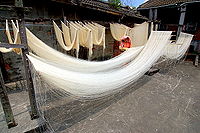- Noodle
-
For other uses, see Noodle (disambiguation).
The noodle is a type of food, made from any of a variety of doughs, formed into long thin ribbons, strips, curly-cues, waves, helices, pipes, tubes, strings, or other various shapes, sometimes folded. They are usually cooked in a mixture of boiling water and/or oil. Depending upon the type, noodles may be dried or refrigerated before cooking. The word derives from the German Nudel (noodle).[1]
In 2002, archaeologists have found an earthenware bowl containing world's oldest known noodles, roughly 4000 years old, at the Lajia archaeological site of the Qijia culture along the Yellow River in China.[2][3][4] The noodles were well-preserved.[2][3] After research with parts of the noodle remains in 2004,[3] scientists have determined that the noodles have been made from foxtail millet and broomcorn millet.[2][3][4] The findings were published in October 2005 by Houyuan Lu et al. in the journal Nature.[5] The earliest written record of noodles is from a book dated to the Eastern Han Dynasty period (25–220).[2] Noodles, often made from wheat dough, became a prominent staple food by the Han Dynasty (206 BCE - 220 CE).[6]
Contents
Types of noodles by primary ingredient
Wheat
- Bakmi: Southeast Asian Chinese yellow wheat noodles with meat, usually chicken
- Chūka men (中華麺): Japanese for "Chinese noodles", used for ramen, chanpon, and yakisoba
- Kesme: flat, yellow or reddish brown Central Asian wheat noodles
- Kalguksu (칼국수): knife-cut Korean noodles
- Lamian (拉麵): hand-pulled Chinese noodles
- Mee pok (麪薄): flat, yellow Chinese noodles, popular in Southeast Asia
- Sōmen (そうめん): thin variety of Japanese wheat noodles, often coated with vegetable oil
- Reshte: Central Asian, flat noodle, very pale in colour (almost white) used in Persian and Afghani cuisine.
- Spätzle: a Swabian type of noodle made of wheat and eggs
- Thukpa (Tibetan: ཐུག་པ་, Wylie: thug pa): flat Tibetan noodles
- Udon (うどん): thicker variety of Japanese wheat noodles
Rice
- Flat or thick rice noodles, also known as hé fěn or ho fun (河粉), kway teow or sen yai (เส้นใหญ่)
- Rice vermicelli: thin rice noodles, also known as mǐfěn (米粉) or bee hoon or sen mee (เส้นหมี่)
- Idiyappam is an Indian rice noodle.
Buckwheat
- Makguksu (막국수): local specialty of Gangwon Province in South Korea
- Memil naengmyeon (메밀 냉면): Korean noodles made of buckwheat. Slightly more chewy than soba.
- Soba (蕎麦): Japanese buckwheat noodles
- Pizzoccheri: Italian buckwheat tagliatelle from Valtellina, usually served with a melted cheese sauce
Others
- Acorn noodles, also known as dotori guksu (도토리국수) in Korean, are made of acorn meal, wheat flour, wheat germ, and salt.
- Olchaeng-chi guksu, meaning tadpole noodles, are made of corn soup put through a noodle maker right into cold water. It was named for its features. They are Korean noodles mostly eaten in Gangwon-do[disambiguation needed
 ].
]. - Cellophane noodles are made from mung bean. These can also be made from potato starch, canna starch or various starches of the same genre.
- Chilk naengmyeon (칡 냉면): Korean noodles made of starch from kudzu root, known as kuzuko in Japanese. Chewy and semi-transparent.
- Shirataki noodles
Types of noodle dishes
- Basic noodles: These are cooked in water or broth, then drained. Other foods can be added (for example a pasta sauce) or the noodles are added to other foods (see fried noodles) or the noodles can be served plain with a dipping sauce or oil to be added at the table. In general, noodles are soft and absorb flavors.
- Frozen noodles: noodles are sometimes served in a salad. An example is the Thai glass noodle salad.
- Fried noodles: dishes made of noodles stir fried with various meats, seafood, vegetables, and dairy products. Typical examples include chow mein, lo mein, mee goreng, hokkien mee, some varieties of pancit, yakisoba, and pad thai.
- Noodle soup: noodles served in broth. Examples are phở, beef noodle soup, chicken noodle soup, ramen, laksa, saimin, and batchoy.
- Noodle casseroles: lasagna, kugel, tuna casserole, baked ziti, timballo, and pastitsio
- Cup noodles
- Instant noodles
See also
References
- ^ Harper, Douglas. "noodle". Online Etymology Dictionary. http://www.etymonline.com/index.php?term=noodle. Retrieved 2009-10-14.
- ^ a b c d Roach, John. "4,000-Year-Old Noodles Found in China". National Geographic. pp. 1-2. http://news.nationalgeographic.com/news/2005/10/1012_051012_chinese_noodles.html. Retrieved 12 October 2011.
- ^ a b c d Ye, Maolin; Lu, Houyuan. "The earliest Chinese noodles from Lajia". The Institute of Archaeology. Chinese Academy of Social Sciences. http://www.kaogu.cn/en/detail.asp?ProductID=986. Retrieved 12 October 2011.
- ^ a b "Oldest noodles unearthed in China", BBC News, 12 October 2005
- ^ Lu, Houyuan; Yang, Xiaoyan, Ye, Maolin, Liu, Kam-Biu, Xia, Zhengkai, Ren, Xiaoyan, Cai, Linhai, Wu, Naiqin, Liu, Tung-Sheng (13 October 2005). "Culinary archaeology: Millet noodles in Late Neolithic China". Nature 437 (7061): 967–968. doi:10.1038/437967a.
- ^ Sinclair, Thomas R.; Sinclair, Carol Janas (2010). Bread, beer, and the seeds of change: Agriculture's imprint on world history. Wallingford: CABI. p. 91. ISBN 9781845937041.
Categories:- Pasta
- Noodles
- Staple foods
Wikimedia Foundation. 2010.




